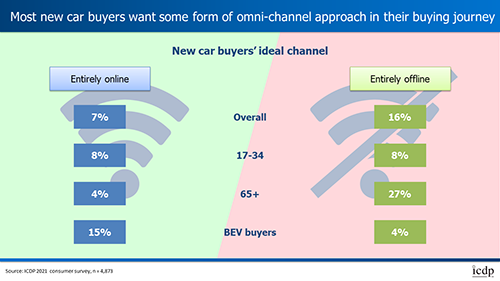
Cox Automotive urges automotive retail businesses to put customers first when building their future omnichannel strategy, paying attention to recent findings from ICDP. In the latest edition of AutoFocus, Cox Automotive outlines the importance of developing an omnichannel approach which combines online and offline touchpoints to deliver an outstanding customer experience and foster loyalty.
Philip Nothard, Insight and Strategy Director at Cox Automotive, explained: “For anyone working in the downstream end of the motor industry, it is clear we’re going through a period of massive change. This has left many retailers confused and wondering how to prioritise their resources. With the emergence of countless new approaches, concepts, and tools, it is easy to forget that these techniques are just fragments of the overall picture that is modern retailing. Our aim should always be to support customers, and we must evolve in line with their needs.”
A joined-up approach
Steve Young, Managing Director of ICDP, summarises the organisation’s recent consumer research, stating: “We found that 80% of customers want to use both online and face-to-face channels during their new car buying journey, rather than solely one or the other. There needs to be more focus on how the two work together in an omnichannel sales approach to offer customers a seamless buying experience.”

Cox Automotive highlights the need for a unified sales process underpinned by IT infrastructure that is accessible to manufacturers, retailers, and customers. Technology can unlock the potential of customer data to create a more efficient retail environment. However, progress in creating such an integrated system has been slow.
The power of people
Although technology has the potential to enrich customer journeys, great people still have the biggest impact in this regard. Steve Young commented: “Customers have repeatedly highlighted that it is people who can make their customer experience great. ICDP research dating back to 2008, when the digital age truly began, has consistently shown that the most influential factor on a car buying journey is the quality of the people at the dealership and the interactions those customers have with them.”
Demonstrating value
Despite the growing importance of online channels, customers still value having physical access to cars, while being able to test drive is an influential factor in purchasing decisions. However, this has become increasingly challenging due to the proliferation of models and variants within most manufacturers’ ranges, so it is impossible to have a truly representative selection on display and to test drive. This highlights another challenge in terms of operational and inventory costs for retailers to store more vehicles.
However, a range of approaches has been adopted to address this, including manufacturer planning and ownership of display and demonstrator cars, having some models available only at regional hubs, using physically larger colour and trim samples, and digital tools, including virtual reality.
Philip Nothard explains: “There are three building blocks of effective retail that work to meet customer’s needs. I would argue that everything else is peripheral or a tactical option for meeting a specific need.
“If, as an industry, we can create a unified retail platform, attract good quality people, and generate an appropriate mix of display and demonstrator cars, then we have the foundations for fully meeting retail customer expectations. Moreover, anyone who achieves this will have the building blocks that allow them to differentiate themselves from competitors who keep trying to apply point solutions to a model that needs more fundamental reform.”






